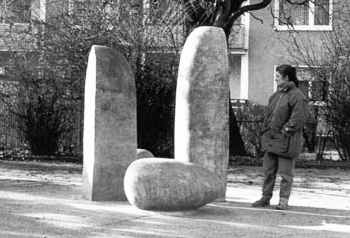| Fixed Point of Meditation, 1988 Created during the second Sculptors’ Meeting of the Town of Troisdorf 4 parts, concrete 150 cm x 150 cm x 220 cm |
||
| We almost automatically think of the standing stones of Stonehenge. Yet the two-meter-high monoliths and two egg-shaped forms that Gabriella Fekete, born in 1944 in Budapest, created for Troisdorf also exude the finality of cult objects beyond the museum environment. They are “born archaic”, as noted in an exhibition catalogue, yet conceived “as a key point, a fixed point for the present” – as a mysterious oracle in the middle of the hustle and bustle of urban life, an invitation to meditate.
First and foremost however, the sculpture, describing a spatial situation with four elements, represents the provisional endpoint of an artistic development that consistently follows the path back to original forms. Gabriella Fekete’s works initially contained references to Wilhelm Lehmbruck, Ernst Barlach or Gerhard Marcks, yet with time she increasingly reduced her formal language. The human figure became a torso, a sarcophagus, a mummy and finally a tomb in the Troisdorf steles, but also a complete reduction of the figure, which, largely forgoing surface design features, overcomes all materiality and radiates an inner glow. Fekete’s earlier pieces, for example the monumental sculpture “Timeline”, which she created on the occasion of her being awarded the “Wilhelm Lehmbruck Fellowship” in 1976 and the theme of which is man as a number, still entailed a specific statement to be decoded, although they were sometimes illustrative. Unlike Gabriella Fekete’s 13-part animation sculpture, which had monumental proportions and, in a schoolyard also in Duisburg, gently introduces schoolchildren to art with abstract letters and at the same time expands the concept of sculpture to include landscape sculpture. Gabriella Fekete has since moved away from such “pedagogic” or content-based art. “Art doesn’t mean something, art is something,” says fellow artist Peter-Michael Schiltsky, a definition that also applies to Gabriella Fekete’s works. Admittedly, it is not easy for the observer; he has to cast off the desire to interpret the piece in order for this mysterious symbol of post-industrial society to open up to him. The abovementioned exhibition catalogue suggests that the sculptures should be seen as “stepping stones between past and future,” and in any case are antennae pointing towards lost cultures and dormant longings. They are a moment of calm, of looking and of thinking. |
||

